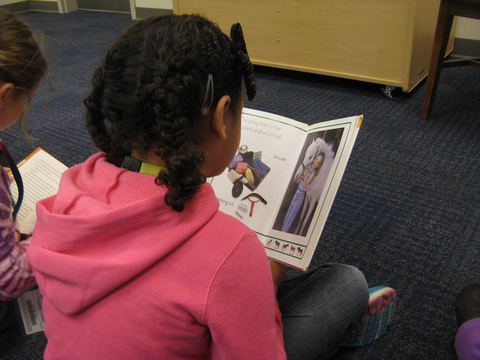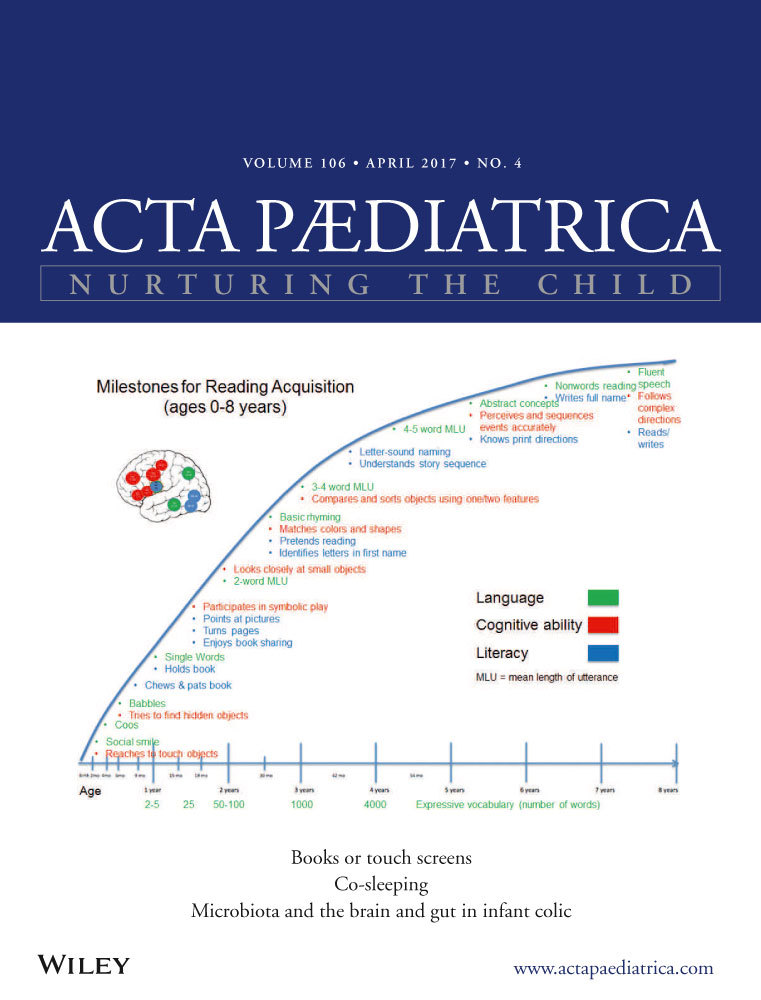How to create a successful reader? Milestones in reading development from birth to adolescence
Corresponding Author
Tzipi Horowitz-Kraus
Educational Neuroimaging Center, Faculty of Education in Science and Technology, Technion, Haifa, Israel
Reading and Literacy Discovery Center, Cincinnati Children's Hospital Medical Center, Cincinnati, OH, USA
Pediatric Neuroimaging Research Center, Cincinnati Children's Hospital Medical Center, Cincinnati, OH, USA
Correspondence
T Horowitz-Kraus, PhD, Educational Neuroimaging Center, Faculty of Education in Science and Technology, Technion, Technion City, Haifa 3200003, Israel.
Tel: +972-4-829-2165 |
Fax: +972-4-822-8084 |
Email: [email protected]
Search for more papers by this authorRachelle Schmitz
Reading and Literacy Discovery Center, Cincinnati Children's Hospital Medical Center, Cincinnati, OH, USA
Search for more papers by this authorJohn S. Hutton
Reading and Literacy Discovery Center, Cincinnati Children's Hospital Medical Center, Cincinnati, OH, USA
Search for more papers by this authorJayna Schumacher
Reading and Literacy Discovery Center, Cincinnati Children's Hospital Medical Center, Cincinnati, OH, USA
Search for more papers by this authorCorresponding Author
Tzipi Horowitz-Kraus
Educational Neuroimaging Center, Faculty of Education in Science and Technology, Technion, Haifa, Israel
Reading and Literacy Discovery Center, Cincinnati Children's Hospital Medical Center, Cincinnati, OH, USA
Pediatric Neuroimaging Research Center, Cincinnati Children's Hospital Medical Center, Cincinnati, OH, USA
Correspondence
T Horowitz-Kraus, PhD, Educational Neuroimaging Center, Faculty of Education in Science and Technology, Technion, Technion City, Haifa 3200003, Israel.
Tel: +972-4-829-2165 |
Fax: +972-4-822-8084 |
Email: [email protected]
Search for more papers by this authorRachelle Schmitz
Reading and Literacy Discovery Center, Cincinnati Children's Hospital Medical Center, Cincinnati, OH, USA
Search for more papers by this authorJohn S. Hutton
Reading and Literacy Discovery Center, Cincinnati Children's Hospital Medical Center, Cincinnati, OH, USA
Search for more papers by this authorJayna Schumacher
Reading and Literacy Discovery Center, Cincinnati Children's Hospital Medical Center, Cincinnati, OH, USA
Search for more papers by this authorAbstract
Reading is one of the most important academic abilities that establishes the foundation for a child's success in school. Therefore, early and accurate diagnosis of reading challenges is crucial for prevention of later academic failure. One challenge in early detection of reading difficulties is that the ability to read typically is acquired explicitly when a child is four to six years of age. However, reading ability relies on development of more basic abilities prior to reading acquisition, starting from birth.
Conclusion
Language, cognitive control and literacy milestones can be evaluated and trained from birth to better acquire reading later in life.
Graphical Abstract
References
- 1Shaywitz SE, Shaywitz BA. Paying attention to reading: the neurobiology of reading and dyslexia. Dev Psychopathol 2008; 20: 1329–49.
- 2 Association ED. About dyslexia: incidence and E-motional effects. 2013.
- 3Krafnick AJ, Flowers DL, Luetje MM, Napoliello EM, Eden GF. An investigation into the origin of anatomical differences in dyslexia. J Neurosci 2014; 34: 901–8.
- 4 IDA. Definition of dyslexia- Based in the initial definition of the Research Committee of the Orton Dyslexia Society, former name of the IDA, done in 1994. International Dyslexia Association, 2011.
- 5Horowitz-Kraus T. All roads lead to Rome? Distinct neural circuits in different developmental disorders are related to reading difficulties in children. Brain Disord Ther 2016; 4: 1–2.
- 6Horowitz-Kraus T, Toro-Serey C. Reading-related neural-circuits disruption in children with dyslexia at a familial-risk for dyslexia. Human Brain Mapping Organization, Honolulu, Hawaii, 2015.
- 7Seidenberg MS, McClelland JL. A distributed, developmental model of word recognition and naming. Psychol Rev 1989; 96: 523–68.
- 8Kintsch W. The role of knowledge in discourse comprehension: a construction-integration model. Psychol Rev 1988; 95: 163–82.
- 9Christopher ME, Miyake A, Keenan JM, Pennington B, DeFries JC, Wadsworth SJ, et al. Predicting word reading and comprehension with executive function and speed measures across development: a latent variable analysis. J Exp Psychol Gen 2012; 141: 470–88.
- 10Vogel AC, Petersen SE, Schlaggar BL. The VWFA: it's not just for words anymore. Front Hum Neurosci 2014; 8: 88.
- 11Pugh KR, Mencl WE, Jenner AR, Katz L, Frost SJ, Lee JR, et al. Functional neuroimaging studies of reading and reading disability (developmental dyslexia). Ment Retard Dev Disabil Res Rev 2000; 6: 207–13.
- 12Horowitz-Kraus T. Pinpointing the deficit in executive functions in adolescents with dyslexia performing the Wisconsin card sorting test: an ERP study. J Learn Disabil 2014; 47: 208–23.
- 13Horowitz-Kraus T, Hutton JS. From emergent literacy to reading: how learning to read changes a child's brain. Acta Paediatr 2015; 104: 648–56.
- 14Kovelman I, Norton ES, Christodoulou JA, Gaab N, Lieberman DA, Triantafyllou C, et al. Brain basis of phonological awareness for spoken language in children and its disruption in dyslexia. Cereb Cortex 2012; 22: 754–64.
- 15Dehaene S. Reading in the brain: the new science of how we read. New York, NY: Penguin Group US, 2009.
- 16Melby-Lervag M, Lyster SA, Hulme C. Phonological skills and their role in learning to read: a meta-analytic review. Psychol Bull 2012; 138: 322–52.
- 17Moon C, Lagercrantz H, Kuhl PK. Language experienced in utero affects vowel perception after birth: a two-country study. Acta Paediatr 2013; 102: 156–60.
- 18van Zuijen TLPA, Maassen BA, Been P, Maurits NM, Krikhaar E, van Driel J, et al. Temporal auditory processing at 17 months of age is associated with preliterate language comprehension and later word reading fluency: an ERP study. Neurosci Lett 2012; 528: 31–5.
- 19Holland SK, Vannest J, Mecoli M, Jacola LM, Tillema JM, Karunanayaka PR, et al. Functional MRI of language lateralization during development in children. Int J Audiol 2007; 46: 533–51.
- 20Kuhl PK, Ramirez RR, Bosseler A, Lin JF, Imada T. Infants’ brain responses to speech suggest analysis by synthesis. Proc Natl Acad Sci U S A 2014; 111: 11238–45.
- 21Berl MM, Duke ES, Mayo J, Rosenberger LR, Moore EN, VanMeter J, et al. Functional anatomy of listening and reading comprehension during development. Brain Lang 2010; 114: 115–25.
- 22Horowitz-Kraus T, Vannest JJ, Holland SK. Overlapping neural circuitry for narrative comprehension and proficient reading in children and adolescents. Neuropsychologia 2013; 51: 2651–62.
- 23Brosnan M, Demetre J, Hamill S, Robson K, Shepherd H, Cody G. Executive functioning in adults and children with developmental dyslexia. Neuropsychologia 2002; 40: 2144–55.
- 24Kieffer MJ, Vukovic RK, Berry D. Roles of attention shifting and inhibitory control in fourth-grade reading comprehension. Read Res Q 2013; 48: 333–48.
- 25Snowling M, Nation K, Moxham P, Gallagher A, Frith U. Phonological processing skills of dyslexic students in higher education: a preliminary report. J Res Read 1997; 20: 31–41.
10.1111/1467-9817.00018 Google Scholar
- 26Horowitz-Kraus T. Can the error-monitoring system differentiate ADHD from ADHD with reading disability? Reading and executive dysfunction as reflected in error monitoring. J Atten Disord 2016; 20: 889–902.
- 27Horowitz-Kraus T, DiFrancesco M, Kay B, Wang Y, Holland SK. Increased functional connectivity of specific brain networks after reading training in dyslexic children. Clin Neuroimage 2015; 8: 619–30.
- 28Diamond A, Lee K. Interventions shown to aid executive function development in children 4 to 12 years old. Science 2011; 333: 959–64.
- 29Rowe JB, Toni I, Josephs O, Frackowiak RS, Passingham RE. The prefrontal cortex: response selection or maintenance within working memory? Science 2000; 288: 1656–60.
- 30Sowell ER, Thompson PM, Holmes CJ, Batth R, Jernigan TL, Toga AW. Localizing age-related changes in brain structure between childhood and adolescence using statistical parametric mapping. NeuroImage 1999; 9: 587–97.
- 31Fair DM, Dosenbach NU, Petersen SE, Schlaggar BL. Resting state studies on the development of control systems. In MI Posner, editor. Cognitive neuroscience of attention. 2nd ed. New York, NY: Guilford Press, 2012: 291–311.
- 32Whitehurst GJ, Lonigan CJ. Child development and emergent literacy. Child Dev 1998; 69: 848–72.
- 33Hutton JS, Horowitz-Kraus T, Mendelsohn AL, DeWitt T, Holland SK. Home reading environment and brain activation in preschool children listening to stories. Pediatrics 2015; 136: 466–78.
- 34Mol SE, Bus AG, de Jong MT, Smeets DJH. Added value of dialogic parent-child book readings: a meta-analysis. Early Educ Dev 2008; 19: 7–26.
- 35Powers SJ, Wang Y, Beach SD, Sideridis GD, Gaab N. Examining the relationship between home literacy environment and neural correlates of phonological processing in beginning readers with and without a familial risk for dyslexia: an fMRI study. Ann Dyslexia 2016; 66: 337–60.
- 36Dehaene S, Cohen L. The unique role of the visual word form area in reading. Trends Cogn Neurosci 2011; 15: 254–62.
- 37Dehaene S, Dehaene-Lambertz G. Is the brain prewired for letters? Nat Neurosci 2016; 19: 1192–3.
- 38Simos PG, Fletcher JM, Bergman E, Breier JI, Foorman BR, Castillo EM, et al. Dyslexia-specific brain activation profile becomes normal following successful remedial training. Neurology 2002; 58: 1203–13.
- 39Horowitz-Kraus T, Buck C, Dorrmann D. Altered neural circuits accompany lower performance during narrative comprehension in children with reading difficulties: an fMRI study. Ann Dyslexia 2016; 66: 301–18.
- 40McCandliss BD, Noble KG. The development of reading impairment: a cognitive neuroscience model. Ment Retard Dev Disabil Res Rev 2003; 9: 196–204.
- 41Breznitz Z, Misra M. Speed of processing of the visual-orthographic and auditory-phonological systems in adult dyslexics: the contribution of “asynchrony” to word recognition deficits. Brain Lang 2003; 85: 486–502.
- 42Facoetti A, Paganoni P, Turatto M, Marzola V, Mascetti GG. Visual-spatial attention in developmental dyslexia. Cortex 2000; 36: 109–23.
- 43Horowitz-Kraus T, Breznitz Z. Can the error detection mechanism benefit from training the working memory? A comparison between dyslexics and controls–an ERP study. PLoS ONE 2009; 4: e7141.
- 44Franceschini S, Gori S, Ruffino M, Viola S, Molteni M, Facoetti A. Action video games make dyslexic children read better. Curr Biol 2013; 23: 462–6.
- 45Ozernov-Palchik O, Gaab N. Tackling the ‘dyslexia paradox’: reading brain and behavior for early markers of developmental dyslexia. Wiley Interdiscip Rev Cogn Sci 2016; 7: 156–76.
- 46Pennington BF. From single to multiple deWcit models of developmental disorders. Cognition 2006; 101: 385–413.
- 47Germano E, Gagliano A, Curatolo P. Comorbidity of ADHD and dyslexia. Dev Neuropsychol 2010; 35: 475–93.
- 48Willcutt EG, Pennington BF, Boada R, Ogline JS, Tunick RA, Chhabildas NA, et al. A comparison of the cognitive deficits in reading disability and attention-deficit/hyperactivity disorder. J Abnorm Psychol 2001; 110: 157–72.
- 49Bental B, Tirosh E. The relationship between attention, executive functions and reading domain abilities in attention deficit hyperactivity disorder and reading disorder: a comparative study. J Child Psychol Psychiatry 2007; 48: 455–63.
- 50Shonkoff JP, Phillips DA, Development CISEC, Board on Children YF, Medicine I, Education DBSS. From neurons to neighborhoods: the science of early childhood development. University of California, Davis, USA: National Academies Press, 2000.
- 51 Assistance NCfEEaR. The condition of education 2015. National Center for Education Statistics under Contract No ED-IES-12-D-0002 with American Institutes for Research. Washington, DC: NCES, IES, U.S. Department of Education, 2015.
- 52 Pediatrics AAo. Media and young minds. Pediatrics 2016; 138: 1–8.
- 53Ardila A, Bertolucci PH, Braga LW, Castro-Caldas A, Judd T, Kosmidis MH, et al. Illiteracy: the neuropsychology of cognition without reading. Arch Clin Neuropsychol 2010; 25: 689–712.
- 54Zuckerman BKA. Reach out and read: evidence based approach to promoting early child development. Curr Opin Pediatr 2010; 22: 539–44.
- 55Coffey S, Guttentag C, Johnson U, Landry S, Zucker T. Little Texans, big future: your early learning guide for infants, toddlers, and three-year-olds. TX, USA: Texas Pediatric Society, 2013.
- 56Lanza JR, Flahive LK. Linguisystems guide to communication milestones 2012 edition. East Moline, IL: LinguiSystems, Inc., 2008. Available at: www.linguisystemscom/freedownloadsphp (accessed on January 10, 2017).
- 57 Program IfHSftOCWT. Developmental milestones chart. Available at: http://www.rsd.k12.pa.us/Downloads/Development_Chart_for_Booklet.pdf (accessed on January 10, 2017).
- 58Lyytinen H, Aro M, Eklund K, Erskine J, Guttorm T, Laakso ML, et al. The development of children at familial risk for dyslexia: birth to early school age. Ann Dyslexia 2004; 54: 184–220.
- 59Puranik CS, Lonigan CJ. Name-writing proficiency, not length of name, is associated with preschool children's emergent literacy skills. Early Child Res Q 2012; 27: 284–94.
- 60Wagner RK, Torgesen JK, Rashotte CA. Comprehensive test of phonological processing (CTOPP). Austin, TX: Pro-Ed, 1999.





